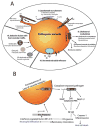Leading a sheltered life: intracellular pathogens and maintenance of vacuolar compartments
- PMID: 19527886
- PMCID: PMC2716004
- DOI: 10.1016/j.chom.2009.05.014
Leading a sheltered life: intracellular pathogens and maintenance of vacuolar compartments
Abstract
Many intracellular pathogens survive in vacuolar niches composed of host-derived membranes modified extensively by pathogen proteins and lipids. Although intracellular lifestyles offer protection from humoral immune responses, vacuole-bound pathogens nevertheless face powerful intracellular innate immune surveillance pathways that can trigger fusion with lysosomes, autophagy, and host cell death. Strategies used by vacuole-bound pathogens to invade and establish a replicative vacuole are well described, but how the integrity and stability of these parasitic vacuoles are maintained is poorly understood. Here, we identify potential mechanisms of pathogenic vacuole maintenance and the consequences of vacuole disruption by highlighting select bacterial and protozoan parasites.
Figures


References
-
- Abrahams GL, Muller P, Hensel M. Functional Dissection of SseF, a Type III Effector Protein Involved in Positioning the Salmonella-Containing Vacuole. Traffic. 2006;7:950–965. - PubMed
-
- Anes E, Kühnel MP, Bos E, Moniz-Pereira J, Habermann A, Griffiths G. Selected lipids activate phagosome actin assembly and maturation resulting in killing of pathogenic mycobacteria. Nat Cell Biol. 2003;5:793–802. - PubMed
Publication types
MeSH terms
Grants and funding
LinkOut - more resources
Full Text Sources

